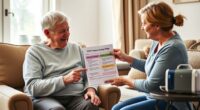To optimize your emergency plan as a caregiver, start by evaluating your environment for hazards and establishing safe zones with clear evacuation routes. Equip your home with essential supplies, medical kits, and reliable communication tools. Regularly train everyone involved through drills and update your plan to reflect changing needs. Collaborate with local emergency services, and address both safety and emotional support. Keeping these elements in check boosts confidence and preparedness—continue exploring for detailed steps to ensure your plan’s effectiveness.
Key Takeaways
- Conduct regular environmental hazard assessments and establish clear safe zones and evacuation routes.
- Prepare emergency kits with essential supplies, medical items, and communication devices, ensuring accessibility.
- Develop and practice detailed communication protocols and emergency drills involving caregivers and care recipients.
- Maintain up-to-date emergency contacts, collaborate with local emergency services, and assign clear roles.
- Regularly review and update the emergency plan to adapt to changing needs and incorporate emotional and personal care strategies.
Assessing the Environment for Emergency Risks
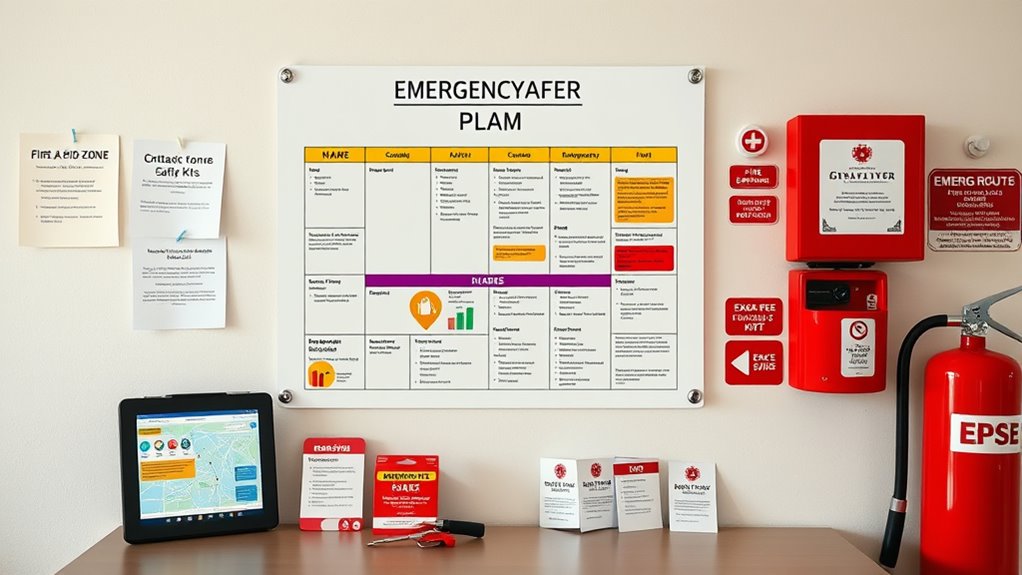
Before an emergency occurs, it’s crucial to carefully evaluate your environment for potential hazards. Conducting an environmental assessment helps you identify home hazards that could worsen a crisis. Look for loose rugs, cluttered walkways, or unstable furniture that could cause falls. Check electrical cords, appliances, and heating sources for safety risks. Consider fire hazards like overloaded outlets or unattended flames. Note any areas prone to flooding or poor ventilation. By recognizing these risks early, you can take steps to minimize dangers and create a safer environment. An environmental assessment empowers you to prepare effectively, reducing the likelihood of accidents during emergencies. Incorporating AI-powered hazard detection tools can further enhance your ability to identify risks proactively. Regularly reviewing your home for hazards ensures you stay vigilant and ready to act swiftly when needed.
Designating Safe Zones and Evacuation Routes
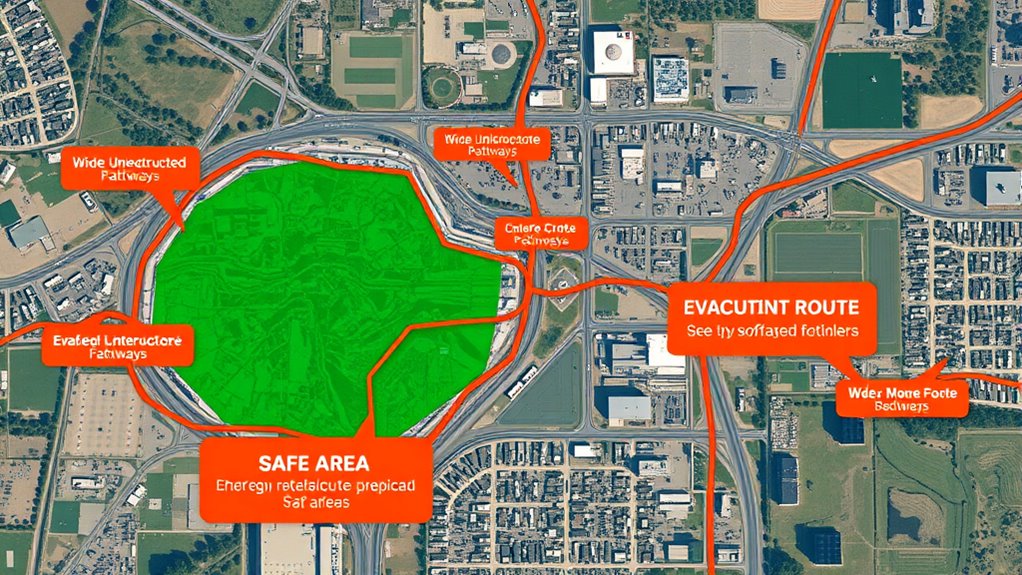
Once you’ve identified potential hazards in your environment, the next step is to establish designated safe zones and clear evacuation routes. These safe zones should be easily accessible, away from fire safety hazards like kitchens or electrical sources. Choose shelter locations that are structurally sound and known to all caregivers and care recipients. Mark these areas clearly with visible signs or floor markings. Make sure evacuation routes are unobstructed and lead directly to your safe zones. Practice evacuations regularly so everyone knows where to go quickly during an emergency. Prioritize routes that are safe from fire hazards and provide quick access to shelter locations. Clear, well-marked routes and designated safe zones help minimize confusion and ensure everyone’s safety during critical moments. Additionally, understanding the contrast ratio of your environment can help optimize lighting conditions to ensure visibility along evacuation paths.
Equipping Emergency Supplies and Resources

To prepare effectively, you need to gather essential emergency supplies like a well-stocked kit and medical supplies. Make sure your communication tools are ready to keep in touch during an emergency, and verify they work properly. Having these resources in place can make a vital difference when every second counts. Additionally, consider incorporating air quality monitors to track indoor air conditions, especially if you or your loved ones have respiratory sensitivities.
Essential Emergency Kit
Having an indispensable emergency kit ready guarantees you’re prepared for unexpected situations. This kit should include basic first aid supplies like bandages, antiseptics, and pain relievers to handle minor injuries quickly. It also plays a crucial role in disaster preparedness by ensuring you have essentials such as bottled water, non-perishable food, flashlights, and batteries. Include any medications your loved ones need and copies of important documents. Keep the kit in an accessible location, and regularly check to replace expired items. An organized emergency kit reduces panic and helps you act swiftly during crises. Proper wall organization can further streamline your emergency response by keeping supplies visible and easy to access. By equipping yourself with the right supplies, you ensure safety and peace of mind for both yourself and those in your care during emergencies.
Communication Tools Readiness
Effective communication during emergencies is essential for coordinating responses and ensuring everyone’s safety. You need to establish clear communication protocols that everyone understands, such as designated contact persons and backup methods. Equipping yourself with reliable messaging strategies, like pre-set text templates or emergency apps, ensures quick and effective exchanges. Make sure your devices are charged and accessible, and consider having multiple communication tools—cell phones, radios, or satellite devices. Regularly test these tools to confirm they work properly. By preparing your communication tools and establishing protocols, you minimize confusion and delays during crises. Clear, reliable messaging helps you coordinate quickly, relay critical information, and keep everyone safe until the situation stabilizes. Incorporating communication training can also improve overall response effectiveness and confidence during emergencies.
Medical Supplies Prepared
Ensuring you have a well-stocked set of medical supplies can make a significant difference during emergencies. You should include essential first aid items like bandages, antiseptics, and gloves to handle injuries swiftly. Proper medication management is also critical; keep a current list of medications, including dosages and schedules, and store them in an accessible, clearly labeled container. Don’t forget to include any specialized supplies your loved ones need, such as inhalers or insulin. Regularly check expiration dates and replenish supplies as needed. Having these items ready guarantees you’re prepared to manage injuries and medication needs promptly, reducing stress and preventing complications during emergencies. Staying organized and up-to-date certifies you’re equipped to provide immediate, effective care when it matters most. Incorporating evidence-based recovery devices can also enhance your ability to manage muscle tension and recovery effectively during stressful situations.
Establishing Communication Protocols
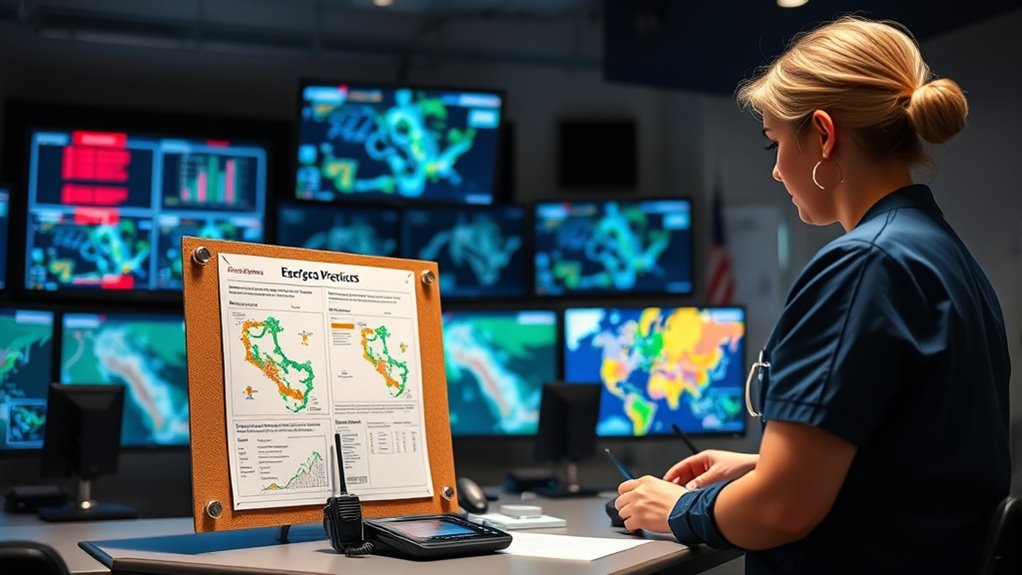
You need reliable communication devices and tools to stay connected during emergencies. Make certain your emergency contact list is up-to-date and easily accessible for everyone involved. Clear protocols ensure that help is on the way when every second counts. Incorporating user-friendly communication platforms can streamline coordination and minimize delays during critical moments.
Communication Devices and Tools
Establishing clear communication protocols is essential for caregivers to respond quickly and efficiently during emergencies. Using the right communication devices and tools guarantees everyone stays connected. Assistive technology, like specialized alarms or speech-generating devices, can enhance communication for those with impairments. Choose reliable tools such as smartphones, radios, or tablets with emergency apps. Always test devices regularly and keep backups prepared. Incorporating Paint Sprayer Reviews & Buying Guides can provide insights into selecting durable and effective communication equipment suitable for various emergency situations.
Emergency Contact List
Creating a thorough emergency contact list is a critical step in setting up effective communication protocols for caregivers. Your list should include all essential contacts, such as family members, neighbors, medical providers, and emergency services. Make certain every contact has current phone numbers and addresses, and update the list regularly. Share this list with everyone involved in the emergency planning process, and keep physical and digital copies accessible. Prioritizing caregiver safety means everyone knows who to call immediately, reducing confusion during crises. Clear communication protocols help guarantee swift action and coordinated responses. By establishing a complete emergency contact list, you create an essential foundation for quick, organized responses, ultimately strengthening your emergency planning and safeguarding everyone’s well-being. Implementing privacy and security measures ensures the confidentiality and protection of sensitive contact information.
Training and Drills for Caregivers and Care Recipients
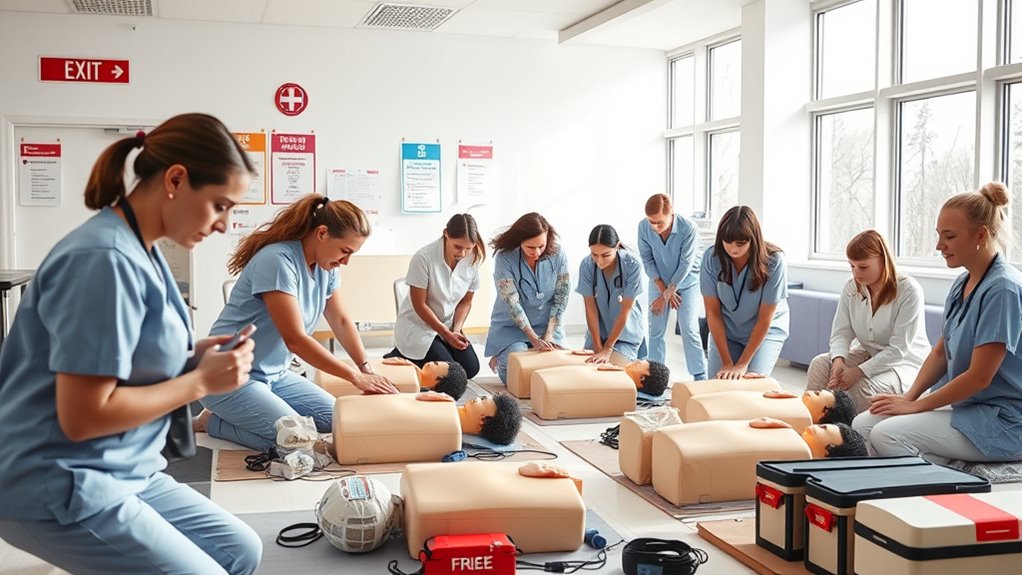
Training and drills are essential components of an effective emergency plan, ensuring that caregivers and care recipients know how to respond quickly and confidently during a crisis. Regular caregiver training helps you understand home safety protocols and emergency procedures, reducing confusion when seconds count. Conducting practice drills allows everyone to rehearse steps like evacuation, using fire extinguishers, or administering basic first aid. These exercises improve coordination and help identify gaps in your plan. By simulating real scenarios, you build confidence and ensure that both caregivers and care recipients are prepared for unexpected events. Consistent training and drills create a safer environment, minimize panic, and enable a swift, organized response during emergencies. Incorporating safety assessments into your routine can further enhance your preparedness by identifying potential hazards before an emergency occurs.
Integrating Medical and Personal Care Considerations
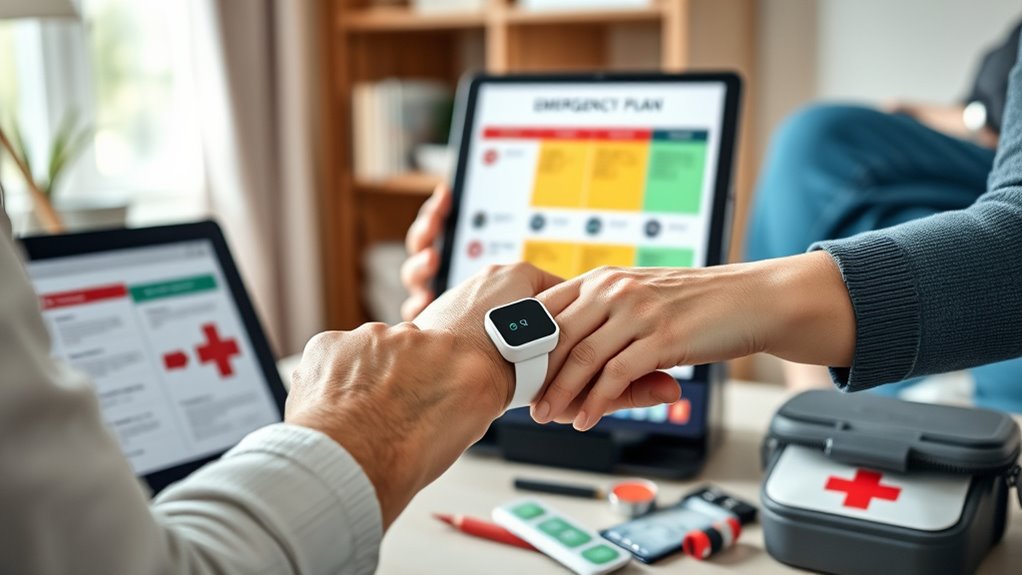
When designing your emergency plan, it’s essential to incorporate medical and personal care considerations to guarantee safety and continuity of care. Start by organizing medication management, ensuring all medications are up-to-date, clearly labeled, and easily accessible. Include instructions for administering medications and note any potential side effects or interactions. Equally important is providing emotional support; plan ways to comfort and reassure your loved one during stressful situations. Keep a list of comforting activities, favorite belongings, or communication methods that help reduce anxiety. By integrating these aspects, you create a thorough plan that addresses both physical needs and emotional well-being. This approach ensures your loved one receives consistent care and feels supported, even in emergencies.
Collaborating With Local Emergency Services

Collaborating with local emergency services is essential to guarantee a swift and effective response during crises. Building strong community partnerships ensures you can access crucial resources quickly and coordinate efforts efficiently. Establishing open communication lines helps you stay informed about local protocols and emergency procedures. Sharing resources, like emergency supplies or contact information, enhances your preparedness. By working with fire departments, police, and medical teams, you create a network that supports your caregiving needs during emergencies. Regular joint exercises can improve response times and clarify roles. This collaboration also fosters trust, so you feel confident in your plan. Ultimately, strong ties with local emergency services help you protect the person in your care while minimizing chaos during critical moments.
Regular Review and Updating of the Emergency Plan

How often do you review and update your emergency plan? Regular reviews are essential to keep the plan effective and adaptable. As a caregiver, you may experience stress that makes sticking to a rigid plan challenging. By scheduling consistent updates, you ensure your plan remains flexible enough to address new risks or changes in your loved one’s condition. Regular reviews also help identify gaps, reduce caregiver stress by increasing confidence, and ensure everyone understands their roles. Keep in mind, emergency plan flexibility is key—life can be unpredictable, so your plan should evolve accordingly. Set a reminder every few months or after any significant event, and involve your loved one in the process to make sure the plan stays current and practical.
Frequently Asked Questions
How Often Should Emergency Plans Be Reviewed and Updated?
You should review and update your emergency plan at least once a year, or immediately after an emergency drill or significant change. Regular emergency drills help identify gaps, ensuring your plan documentation stays current and effective. Make it a habit to revisit your plan periodically, especially when new caregivers join or there are changes in the care environment. Staying proactive helps keep everyone prepared and safe during emergencies.
What Legal Considerations Should Caregivers Be Aware of During Emergencies?
During emergencies, you must understand your legal obligations, obtain proper consent, and follow protocols diligently. You should guarantee that you respect patient rights, document actions clearly, and adhere to confidentiality laws. Recognize the importance of informed consent, act within your scope of practice, and stay updated on legal requirements. By doing so, you protect both yourself and those you care for, maintaining trust and legal compliance at all times.
How Can Technology Enhance Emergency Communication Effectiveness?
You can enhance emergency communication effectiveness through tech integration by using communication tools like mobile apps, messaging platforms, and emergency alert systems. These tools enable rapid information sharing, real-time updates, and coordinated responses, ensuring everyone stays informed and connected. By leveraging technology, you reduce delays, improve clarity, and streamline your emergency plans, making it easier to protect those in your care during critical moments.
What Psychological Support Is Recommended for Caregivers and Recipients Post-Disaster?
You should prioritize psychological resilience and emotional support after a disaster. Seek counseling or support groups to process trauma, and encourage open communication to share feelings. Practice self-care strategies like mindfulness and relaxation techniques. Recognize that recovery takes time, and maintaining strong social connections fosters resilience. By actively addressing emotional needs, you help both yourself and recipients rebuild stability, ensuring a healthier mental outlook amidst recovery.
How to Coordinate Emergency Plans With Neighbors and Community Resources?
You should actively engage with your community by participating in neighborhood meetings and building relationships with neighbors. Use resource mapping to identify local emergency services, shelters, and support networks. Coordinate with community resources by sharing your needs and plans, ensuring everyone’s efforts align. This collaboration strengthens your emergency plan, making it more effective and reliable during crises. Regular communication and planning with neighbors are key to a resilient, well-prepared community.
Conclusion
By proactively setting up your emergency plan, you can considerably reduce risks and guarantee safety for everyone involved. Regularly reviewing and practicing your plan boosts confidence and preparedness. Did you know that families who rehearse emergency drills are 50% more likely to respond effectively during real crises? Stay vigilant, stay prepared, and keep your plan updated—because being ready now can make all the difference when emergencies strike.

